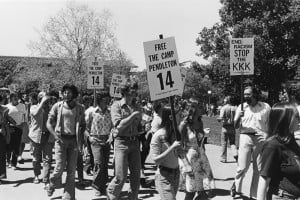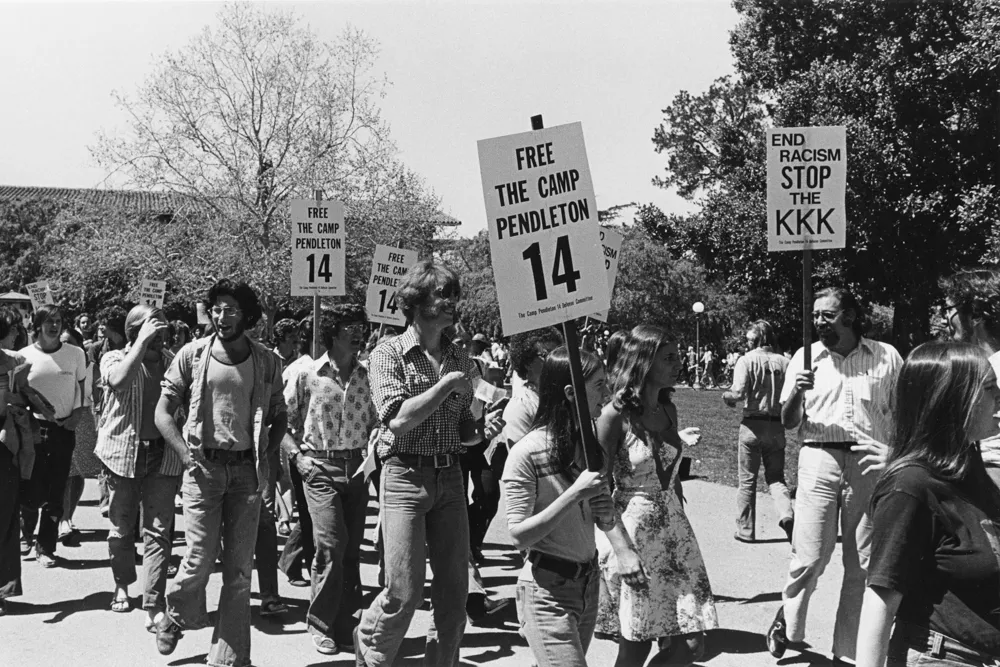“I prefer free white citizens to any other class or race. I prefer the white man to the negro as an inhabitant of our country.”
These polarizing words were spoken by Leland Stanford in 1859, as he accepted the Republican Party nomination as governor of California. He would go on to found Stanford University in 1891.
Yet this discriminatory mindset held by Stanford and others of his time no longer commands the same influence on this campus as the University celebrates the 40th anniversary of the Civil Rights Act of 1964, which ended all major forms of discrimination based on race, ethnicity, nationality, religion or gender.
Civil rights at Stanford
According to Clayborne Carson, professor of history and director of the Martin Luther King, Jr., Research and Education Institute, Stanford has changed dramatically in the years following this legislation, with the “white Anglo-Saxon, Protestant background” becoming the minority on campus.

As a student at UCLA during the Civil Rights movement in the 1960s, Carson had worked in Los Angeles with the Student Nonviolent Coordinator Committee (SNCC).
“We didn’t have segregated lunch counters, [but] we dealt with employment discrimination, trying to get the black community in Los Angeles not to buy things from businesses that refused to hire black people as clerks,” he said.
Carson noted that in the wake of the assassination of Martin Luther King, Jr., various campuses — including Stanford, UCLA and Berkeley — began offering courses in African American history for the first time, and those schools started looking for black students for their graduate schools so that they eventually could teach in that field.
“I knew that many students at Stanford were involved in the movement and when I arrived here, there were still people around who were a big part of that,” he said. “At that point, most of the activism of the mid-1960s reached its peak during the anti-war campaign during the early ’70s.”
Carson added that in the early ’80s, the South African apartheid struggle stimulated another burst of activism.
“The ’80s were for Stanford what the ’60s were for Berkeley,” he said. “That was the period when the campus was the most politicized…The number of black students was increasing, along with significant numbers of Latino and Asian students, all with the attitude of, ‘Yes, I’m really thankful to get admitted, but while I’m here, I’m not going to treat Stanford as if it can’t be transformed into something different, something better.’”
For history professor James Campbell ’83 Ph.D. ’89, remembering the Civil Rights movement is more than just celebrating the positive outcomes but also understanding its complexities and human costs, such as the struggles specific to Mississippi’s civil rights movement.
“Mississippi was a different kind,” Campbell said. “Martin Luther King, Jr., spent very little time there, as it was far more dangerous as a citadel of Jim Crow laws. The kind of movement that emerged elsewhere — in which you had movements associated with King’s large-scale demonstrations in public spaces, freedom rides, the sit-ins at the lunch country, the Montgomery bus boycott — that’s not what was happening in Mississippi.”
According to Campbell, in Mississippi, a small number of people began working under the Student Nonviolent Coordinating Committee (SNCC), registering people to vote and trying to create a group-centered leadership. They actively opposed the vision of politics enshrined by King and the Southern Christian Leadership Conference, a civil rights organization spearheaded by King.
“[SNCC] didn’t want to make followers, because if you did that, what was left when you left?” Campbell said. “Instead, they tried to identify, tap into and nurture the capacity for leadership and wisdom that was indigenous to small communities and people living in a brutal society of white supremacy.”
After facing violent opposition — including arrests and murders — and realizing that the murders of its black supporters made little stir in national conversation, SNCC decided to create a summer project to recruit students from white, northern universities, including students from Stanford, to help with the organizing work in the summer of 1964.
“They decided the nation was never going to care unless they brought the nation’s children to Mississippi,” Campbell said. “Once some of them got killed, then the nation would pay attention. And that’s exactly what happened. Three students were killed and it became front-page news.”
Ongoing discussions
While such issues of civil rights no longer command as much presence in current campus discourse as they did in the past, activism remains of interest for many Stanford students.
“Activism through social media, nationally, has emerged as another means of activism,” said Jan Barker-Alexander, director of the Black Community Services Center and Resident Fellow in Ujamaa.
However, she acknowledged that students at Stanford sill struggle with what it means to be an activist, in terms of defining the broadness or narrowness of the term, and with talking about race in general.
“Oftentimes, people feel that they are being accused of something when it really is people wanting to have a dialogue and a courageous conversation about issues that are difficult,” she said. “If people were to step out of their comfort zone…they would begin to gain an understanding of current-day issues of how race and racism are still a part of the fabric of America.”
For Kaela Farrise ’14, co-president of the Black Student Union (BSU), Stanford makes a well-intentioned effort to create the space for different racial and ethnic groups to come together and share their stories, but doesn’t make it a first priority.
“Sometimes, especially during elections every year, the burden is put on the students of these groups to prove their worth,” she said. “It’s put on the students to defend our spaces…Conversations that you might hear about Ujamaa and the BSU are oftentimes negative or talk about self-segregation, and that conversation needs to be framed differently. There should be an institutional explanation for why we are here.”
According to Farrise, one of the important parts of the BSU is bringing the conversation about race to the forefront of people’s minds.
“It’s important for us to have a collaboration with other groups, because it’s our job to make sure that our community has a sense of belonging at Stanford and a sense of owning a part of Stanford,” she said.
Contact Josee Smith at [email protected].
